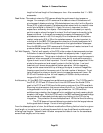
Section 4 - Camera Hardware
Page 25
the relay is inactivated there is a connection between the Common and the Normally Closed
contact. When the relay is activated (trying to correct the telescope) the contact is between the
Common and the Normally Open contacts.
If your hand controller is from a relatively recent model telescope it probably has four
buttons that have a "push to make" configuration. By "push to make" we mean that the
switches have two contacts that are shorted together when the button is pressed. If that's the
case then it is a simple matter of soldering the Common and Normally Open leads of the
appropriate relay to the corresponding switch, without having to cut any traces, as shown in
Figure 4.1 below.
A: Unmodified Push to Make Switch
switch
B: Modified Push to Make Switch
normally open
common
switch
relay
c
nonc
Figure 4.1 - Push to Make Switch Modification
Another less common type of switch configuration (although it seems to have been used more
often in older hand controllers) involve hand controller buttons that use both a push to make
contact in conjunction with a push to break contact. The modification required for these
switches involves cutting traces or wires in the hand controller. Essentially the relay's
Normally Open is wired in parallel with the switch (activating the relay or pushing the hand
controller button closes the Normally Open or Push to Make contact) while at the same time the
Normally Closed contact is wired in series with the switch (activating the relay or pushing the
hand controller button opens the Normally Closed or the Push to Break contact). This type of
switch modification is shown in Figure 4.2 below.
c
nonc
switch
common
normally open
normally closed
A: Unmodified Push to Make/Break Switch
B: Modified Push to Make/Break Switch
normally open
normally closed
c
nonc
relay
common
c
nonc
Figure 4.2- Push to Make/Break Modification
The last type of hand controller that is moderately common is the resistor joystick. In this
joystick each axis of the joystick is connected to a potentiometer or variable resistor. Moving
the joystick handle left or right rotates a potentiometer, varying the resistance between a central
"wiper" contact and the two ends of a fixed resistor. The relays can be interfaced to the joystick
as shown in Figure 4.3 below. Essentially the relays are used to connect the wire that used to
attach to the wiper to either end of the potentiometer when the opposing relays are activated.


















